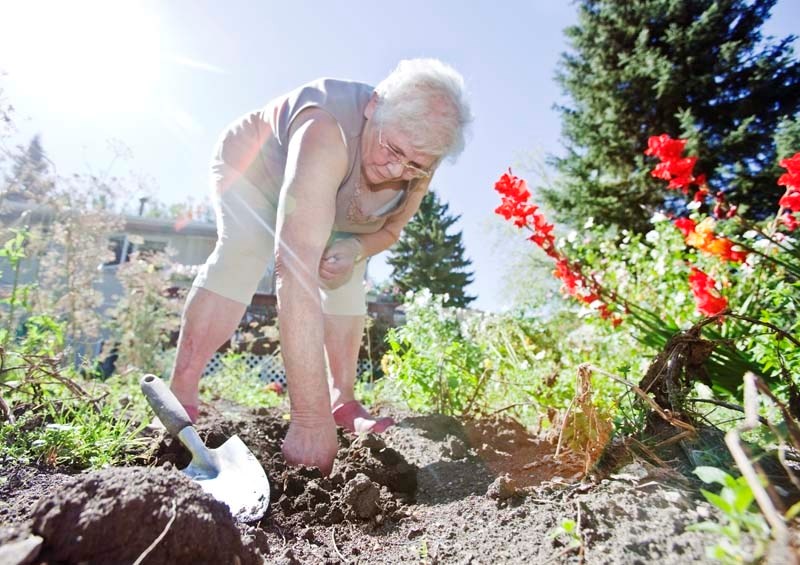It’s hard to grow garlic successfully in Alberta. To develop a full, big bulb of cloves, garlic needs to be planted in the fall, and it grows best if it’s planted near the surface. When the ground freezes, so does the garlic.
Longtime St. Albert Garden Club member Olga Matvichuk has a huge, lush vegetable garden, but she hasn’t had any luck growing garlic.
“I’ve tried planting garlic over the years and it’s not been successful,” Matvichuck said.
Local greenhouse personnel say it’s best to plant garlic early so it can get rooted before the frost hits.
“It’s best to plant it at least three weeks before freeze-up, and early September is best,” said Stephen Raven, of Hole’s Greenhouses and Gardens.
He said even the suppliers in the Netherlands had difficulty with garlic this year.
“The shipment was late coming in because the bulbs hadn’t developed enough, due to weather conditions in Holland,” Raven said.
Choosing the right kind of garlic to plant may be half the battle.
Red/purple varieties such as Ukrainian Red Chesnok, German Red or Russian Red garlic may be hardier and may grow better in this climate.
“Choose a bulb that has a nice shape with plump cloves. The cloves shouldn’t be all shrivelled. The clove size is more important than the bulb size, because it’s the cloves that you plant – not the bulb,” said Tam Andersen from Prairie Gardens and Greenhouses.
Bulbs purchased in the produce section at the supermarket may or may not grow.
“You could certainly try it, but often the garlic is treated with a growth regulator to prevent it from sprouting. They do the same thing with ginger root. But you cannot tell just by looking at it whether or not it has been sprayed. You’d have to ask someone at the store,” Raven said.
Garlic is a multiplier plant, so crack the bulb open, just as you might do if you were cooking, split the cloves apart and plant them. Space the cloves four to eight inches apart and plant them about two inches below the surface.
“To do that, the soil needs to be nicely worked up. I would plant them about knuckle deep and I’d space them far enough apart so that there is room for a big bulb to grow,” Andersen said.
Later in the fall, just before the ground freezes hard, she recommends adding a protective layer of mulch.
“Don’t put the mulch on too early, or the mulch may turn your garlic to compost. Usually the last week of October, when the daytime temperature is around minus five Celsius, is a good time to mulch,” she said.
Andersen prefers wheat straw for mulch, because it has a hollow stem and therefore has the best insulating abilities, but the mulch may be dry leaves, peat moss or even dry grass clippings. The trick with mulch is to cover plants with dry organic material that doesn’t rot around the plant. If it’s dry and cold enough when you cover the plants, the mulch can easily be pulled off in the spring.
“In the spring, poke around to see if it’s sprouting. The first indicator that it’s growing will be a white tip. Then if the weather is warm, pull the mulch back a bit to let the sun and the air in, but don’t pull it back so far that you cannot cover it up again if it turns really cold. Usually I pull the mulch off completely in the first week of May,” Andersen said.
Tiny garlic cloves are so small, you might forget where they are, so mark the spot, so you don’t go planting something else on top of them. In the spring they will look like onion tops and will soon produce a white flower-like sprout on a curling stem called a garlic scape. Cut the scape off and use it in your salads.
“If you cut the flowers off, all the energy will go into producing a bigger bulb,” Raven said.
Garlic may be planted in the spring too, if all you wish for is the green tops to use in salads, but it is unlikely to produce a full bulb.
“The purpose for planting in the fall, is that it needs what we call vernalization. It needs to over-winter to set up the cloves,” Andersen said.
By August the garlic stems will start to brown and that means it’s ready to harvest. Use it in cooking, but if you want to try growing again, braid the garlic tops together and hang them from the rafters in the garage to dry. Then split them up and plant them again.




